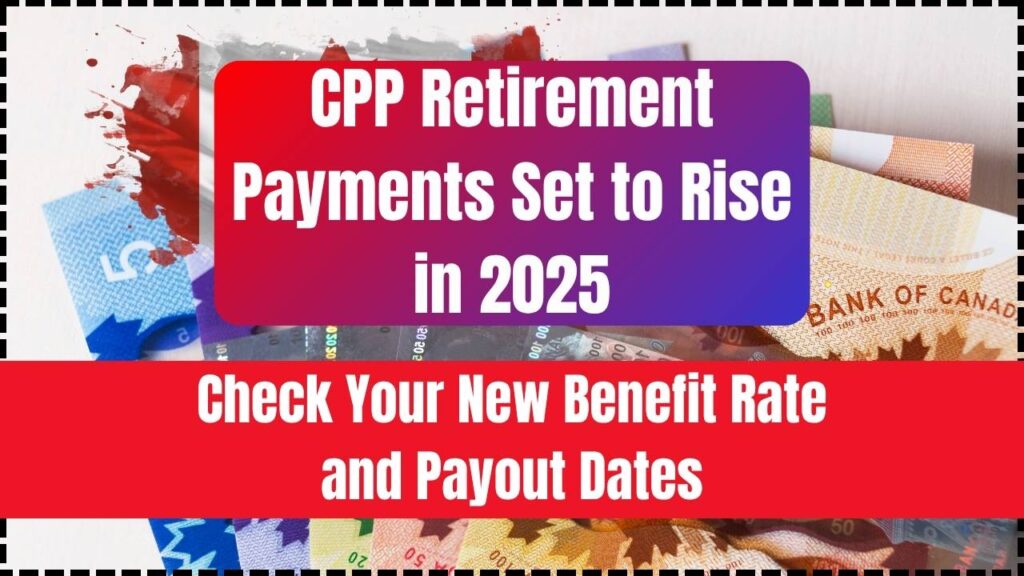
CPP Retirement Payments Set to Rise in 2025: If you’re planning for retirement in Canada—or already drawing your Canada Pension Plan (CPP)—you’re in for some good news. In 2025, CPP retirement payments are increasing, thanks to adjustments tied to inflation and ongoing enhancements. Whether you’re already receiving benefits or planning ahead, it’s essential to understand how these changes affect your financial security. Let’s dive deep into what’s new, why it matters, and how you can make the most of it.
CPP Retirement Payments Set to Rise in 2025
The 2025 CPP updates bring higher payments, enhanced contribution limits, and better income security. Whether you’re planning ahead or already retired, these changes matter. Start by reviewing your CPP contributions and consider delaying your benefits for a bigger payoff. Stay informed, plan smart, and enjoy peace of mind for your retirement.
| Feature | 2025 Update |
|---|---|
| Maximum Monthly CPP at Age 65 | $1,433.00 |
| Average Monthly CPP Payment | $899.67 |
| Annual CPI Adjustment | 2.6% |
| Year’s Maximum Pensionable Earnings (YMPE) | $71,300 |
| Year’s Additional Maximum Pensionable Earnings (YAMPE) | $81,200 |
| Employee/Employer Contribution Rate | 5.95% (up to YMPE), 4.00% (YMPE to YAMPE) |
| Self-Employed Contribution Rate | 11.90% (up to YMPE), 8.00% (YMPE to YAMPE) |
| CPP Payment Dates | Monthly, typically the third-to-last business day |
| Official Source | Canada.ca – CPP Payment Amounts |
Understanding the 2025 CPP Payment Increase
Starting January 2025, the maximum monthly CPP payment at age 65 rises to $1,433.00, with the average monthly payment for new beneficiaries hitting $899.67. This 2.6% bump reflects the Consumer Price Index (CPI) adjustment, designed to keep pace with inflation.
It’s crucial to remember that your actual CPP payment depends on several factors:
- Your total contributions over your career
- The number of years you contributed
- The age you begin receiving benefits
For instance, if you start taking CPP at age 60, your monthly payments will be reduced (by about 7.2% per year early). On the flip side, delaying until age 70 can boost your payments by up to 42%.
CPP Payment Dates for 2025
Plan your budget around these 2025 CPP payment dates:
- January 29
- February 26
- March 27
- April 28
- May 28
- June 26
- July 29
- August 27
- September 25
- October 29
- November 26
- December 22
Keep in mind, payments may come a bit earlier if holidays or administrative adjustments occur.
The CPP Enhancement Explained
Introduced in phases since 2019, the CPP enhancement boosts retirement income security. Here’s what’s changing:
- Income Replacement Rate Increase: The plan now aims to replace one-third of your average work earnings, up from the previous 25%.
- Raised Maximum Earnings Limit: The YMPE climbs to $71,300, and a new YAMPE tier of $81,200 applies for higher earners.
These changes mean that if you contribute more—and for longer—you’ll see a bigger payoff when you retire.
Real-Life Scenarios
Case 1: Early Starter
Sophie, age 60, decides to start her CPP. Her payment is reduced by about 36% because she’s starting five years before 65. While the payments begin earlier, they’re smaller over her lifetime.
Case 2: Delayed Approach
Mark, age 70, delays CPP until the last possible moment. His payments increase by a whopping 42%, maximizing his monthly income.
Case 3: Middle-of-the-Road
Aisha, age 65, starts CPP right at full retirement age. Her payments align with the maximum rates for 2025.
CPP Contribution Rates for 2025
Understanding contributions is key:
- Employees and Employers: 5.95% on earnings up to YMPE, 4.00% on earnings from YMPE to YAMPE.
- Self-Employed: 11.90% up to YMPE, 8.00% on YMPE-YAMPE earnings.
These rates ensure fair contributions while providing a safety net for higher-income workers.
Expert Tips to Maximize CPP Benefits
Here’s how to get the most from your CPP:
- Contribute for at least 39 years to qualify for maximum payments.
- Delay your CPP if you can afford to, increasing monthly income dramatically.
- Coordinate with other income sources like RRSPs and OAS for a balanced retirement strategy.
- Use official tools like the Canadian Retirement Income Calculator to estimate your future benefits.
How CPP Fits into Your Retirement Plan
CPP is just one piece of the puzzle. Combine it with other savings vehicles such as:
- RRSPs (Registered Retirement Savings Plans) for tax-deferred growth.
- OAS (Old Age Security) benefits starting at 65.
- Private pensions from your employer or personal investments.
A well-rounded retirement plan draws from multiple sources to ensure stable, reliable income for your golden years.
Eligibility and How to Apply for CPP Retirement Payments Set to Rise in 2025
- Age: You must be at least 60 years old.
- Contributions: At least one valid contribution is required.
Apply online via My Service Canada Account or through a paper application.
Canada’s $2200 Payment Hits This Month—Are You Eligible for the Cash?
$750 + $890 Double CPP Payment in June 2025 – Fact Check Here, Eligibility & Payment Date
Canada Confirms $500 One-Time Relief—Who Qualifies and When to Expect Your Payment
Frequently Asked Questions (FAQs)
Q: Can I work and receive CPP?
Yes, and if you’re under 70, you can contribute to the Post-Retirement Benefit (PRB) to increase your CPP.
Q: Are CPP payments taxable?
Absolutely. You can opt to have taxes withheld or pay when you file.
Q: What’s the fastest way to apply?
Online through your My Service Canada Account is the quickest route.











